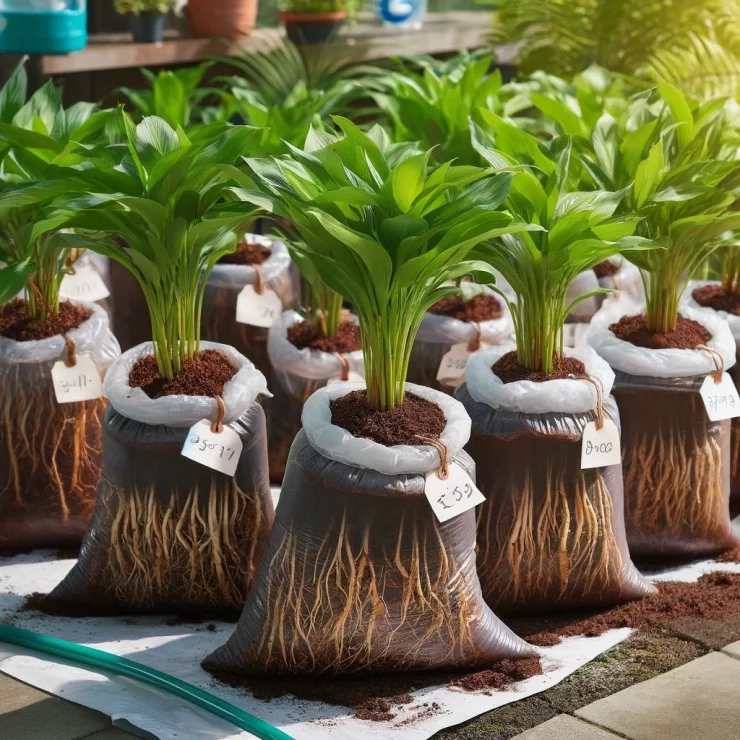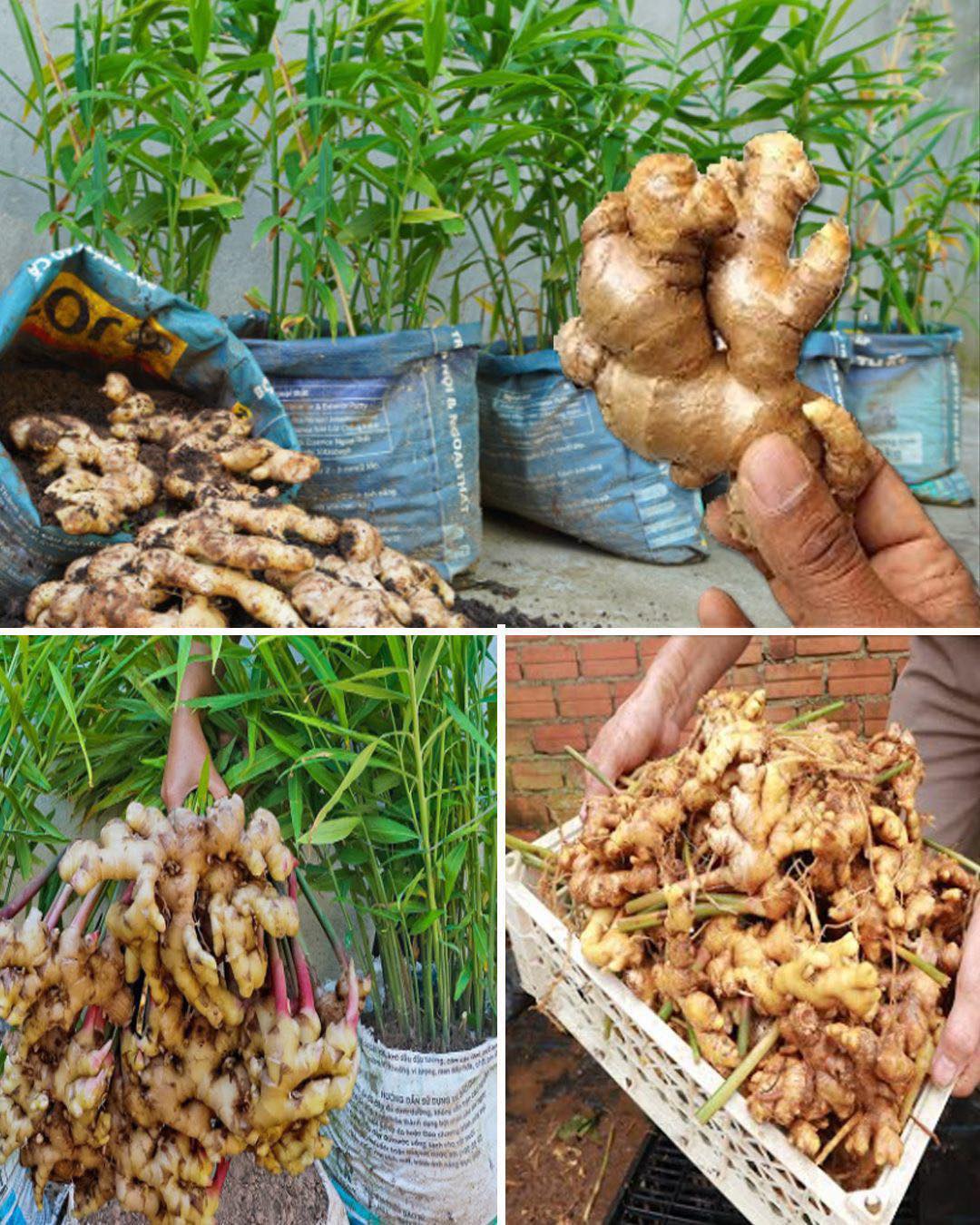Ginger, with its spicy aroma and culinary versatility, is a staple ingredient in kitchens worldwide. But did you know that you can easily grow this flavorful root at home, even if you have limited space? In this guide, we’ll explore the innovative method of growing ginger in plastic bags, revealing the secrets to achieving a fast and bountiful harvest right on your doorstep.

Why Grow Ginger in Plastic Bags?
Growing ginger in plastic bags offers several advantages over traditional methods:
Space Efficiency: Plastic bags require minimal space, making them ideal for urban dwellers or anyone with limited gardening space.
Portability: Plastic bags are lightweight and portable, allowing you to move your ginger plants around to find the perfect spot for sunlight and warmth.
Moisture Retention: Plastic bags help retain moisture, creating a humid environment that promotes healthy root growth.
Weed Control: By containing the soil within the bag, you can prevent weeds from competing with your ginger plants for nutrients and space.
Getting Started
Here’s what you’ll need to get started:
Ginger Rhizomes: Look for plump, firm rhizomes from a reputable source or your local grocery store.
Large Plastic Bags: Opt for sturdy plastic bags with drainage holes to prevent waterlogging.
Potting Mix: Choose a well-draining potting mix rich in organic matter.
Watering Can: To keep your ginger plants properly hydrated.
Sunlight: Locate a spot with partial sunlight or dappled shade.
Step-by-Step Guide
Follow these simple steps to grow ginger in plastic bags:
Prepare the Plastic Bags: Fill each plastic bag with potting mix, leaving a few inches of space at the top. Ensure that the bags have drainage holes punched in the bottom to prevent waterlogging.
Select and Prepare the Rhizomes: Choose healthy ginger rhizomes with multiple buds or “eyes.” Cut the rhizomes into sections, ensuring that each section has at least one visible bud.
Planting: Place the ginger rhizome sections horizontally on top of the potting mix in each bag, with the buds facing upward. Cover the rhizomes with a thin layer of potting mix, leaving the buds exposed.
Watering: Water the soil thoroughly until it’s evenly moist but not waterlogged. Keep the soil consistently moist throughout the growing season, but avoid overwatering, as this can cause rot.
Placement: Place the plastic bags in a location with indirect sunlight or dappled shade. Ginger prefers warm, humid conditions, so choose a spot with adequate warmth and airflow.
Maintenance: Keep an eye on your ginger plants and water them regularly to maintain moisture levels. You can also fertilize them with a balanced fertilizer every few weeks to promote healthy growth.
Harvesting: Depending on the variety, ginger typically takes 8 to 10 months to mature. Once the plants reach maturity, you can harvest fresh ginger by gently digging up the rhizomes from the soil. Leave some rhizomes in the soil to continue growing for future harvests.

Tips for Success
Temperature: Ginger thrives in warm temperatures between 75°F and 85°F (24°C to 29°C). Protect your plants from cold drafts and temperature fluctuations.
Humidity: Maintain a humid environment by misting the plants regularly or placing a tray of water near them to evaporate and increase humidity.
Pests and Diseases: Keep an eye out for common pests like aphids and spider mites, and treat any infestations promptly. Avoid overwatering to prevent root rot and fungal diseases.
Growing ginger in plastic bags is a simple and rewarding way to enjoy a bountiful harvest of fresh, flavorful ginger right at home. With the right care and attention to detail, you can cultivate healthy ginger plants that will provide you with an abundant supply of this versatile spice for all your culinary adventures. So why wait? Grab your plastic bags and get ready to grow your own ginger
News
JJ Redick reacts to Luka Doncic trade for Anthony Davis
In one of the most jaw-dropping moves of the season, the NBA landscape was rocked by the blockbuster trade involving Luka Dončić and Anthony Davis—a swap that has sent ripples of excitement, disbelief, and heated discussion through the league. Among…
Anthony Davis FULL reaction to trade to Mavericks for Luka Doncic
In a blockbuster move that sent shockwaves through the NBA and left fans reeling, Anthony Davis has been traded to the Dallas Mavericks in exchange for Luka Dončić. In the immediate aftermath of the news, Davis took to the media…
Shaq reacts to Dallas Mavericks wanting Kevin Durant after Luka-AD trade 👀
In the constantly shifting world of the NBA, trade rumors and blockbuster moves are a regular part of the season’s drama. The latest twist has fans buzzing: the Dallas Mavericks have reportedly set their sights on acquiring Kevin Durant in…
Donovan Mitchell FILTHY poster dunk on Kristaps Porzingis 😳
In a game filled with high-intensity moments and jaw-dropping highlights, one play in particular has left fans and analysts buzzing about Donovan Mitchell’s latest display of athleticism. Early in the contest, with the atmosphere already charged by an evenly matched…
Joel Embiid hits go-ahead bucket vs Mavs then chats with Anthony Davis after game
In one of the most thrilling contests of the season, Joel Embiid delivered a clutch performance against the Dallas Mavericks, punctuating the game with a go-ahead bucket that sent the home crowd into a frenzy. The atmosphere in the arena…
D’Angelo Russell game winner as Nets hit two 3’s in 3 seconds to win vs Rockets 😱
In one of the most electrifying moments in recent NBA history, D’Angelo Russell delivered an unforgettable game-winner that left fans and commentators in complete awe. With the Brooklyn Nets locked in a tense battle against the Houston Rockets, the outcome…
End of content
No more pages to load











